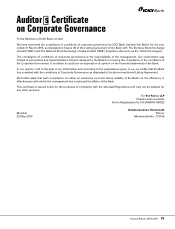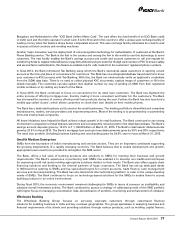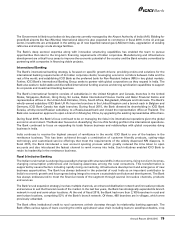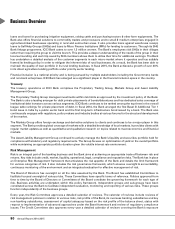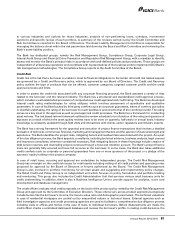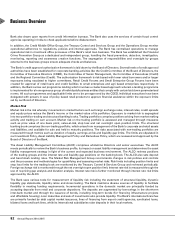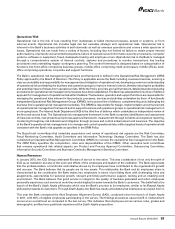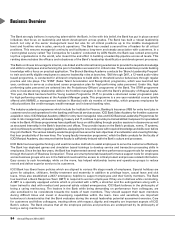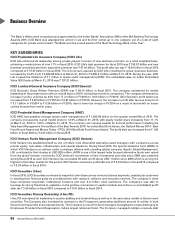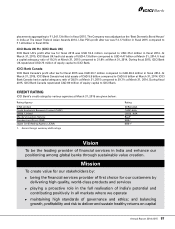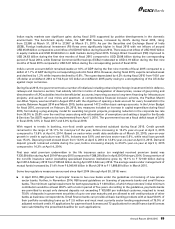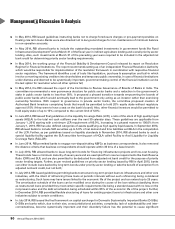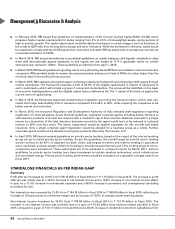ICICI Bank 2015 Annual Report Download - page 85
Download and view the complete annual report
Please find page 85 of the 2015 ICICI Bank annual report below. You can navigate through the pages in the report by either clicking on the pages listed below, or by using the keyword search tool below to find specific information within the annual report.
83Annual Report 2014-2015
Operational Risk
Operational risk is the risk of loss resulting from inadequate or failed internal processes, people or systems, or from
external events. Operational risk includes legal risk but excludes strategic and reputational risks. Operational risk is
inherent in the Bank’s business activities in both domestic as well as overseas operations and covers a wide spectrum of
issues. Operational risk can result from a variety of factors, including (but not limited to) failure to obtain proper internal
authorisations, improperly documented transactions, failure of operational and information security procedures, computer
systems, software or equipment, fraud, inadequate training and employee errors. Operational risk in the Bank is managed
through a comprehensive system of internal controls, systems and procedures to monitor transactions, key backup
procedures and undertaking regular contingency planning. The control framework is designed based on categorisation of
functions into front-office comprising business groups, middle office comprising credit and treasury middle offices, back-
office comprising operations, corporate and support functions.
The Bank’s operational risk management governance and framework is defined in the Operational Risk Management (ORM)
Policy approved by the Board of Directors. The Policy is applicable across the Bank including overseas branches, ensuring a
clear accountability and responsibility for management and mitigation of operational risk, developing a common understanding
of operational risk and helping the business and operation groups to improve internal controls, thereby reducing the probability
and potential impact of losses from operational risks. While the Policy provides a broad framework, detailed standard operating
procedures for operational risk management processes have been established. The Bank has adopted the three lines of defence
approach for management of operational risk within the Bank. The business, operation and support functions are responsible for
managing the operational risks inherent in the products, processes, services and activities undertaken by them. A functionally
independent Operational Risk Management Group (ORMG) is the second line of defence, complementing and challenging the
business line’s operational risk management activities. The ORMG is responsible for design, implementation and enhancement
of operational risk management framework and to support business and operations groups in operational risk management on
an on-going basis. The Internal Audit Department (IAD) is the third line of defence which undertakes an independent review of
the first and second lines. The Operational risk management framework in the Bank comprises identification and assessment
of risks and controls, new products and process approval framework, measurement through incidents and exposure reporting,
monitoring through key risk indicators and mitigation through process and control enhancement and insurance. The objective
of the Bank’s operational risk management is to manage and control operational risks within targeted levels of operational risk
consistent with the Bank’s risk appetite as specified in the ORM Policy.
The Board level committees that undertake supervision and review of operational risk aspects are the Risk Committee,
Fraud Monitoring Committee, Audit Committee and Information Technology Strategy Committee. The Bank has also
constituted an Operational Risk Management Committee (ORMC) to oversee the operational risk management in the Bank.
The ORM Policy specifies the composition, roles and responsibilities of the ORMC. Other executive level committees
that oversee operational risk related aspects are Product and Process Approval Committee, Outsourcing Committee,
Information Security Committee and Business Continuity Management Steering Committee.
Human Resources
In January 2015, the ICICI Group celebrated 60 years of service to the nation. This was a celebration of not only the spirit of
ICICI as an institution but also of the work and efforts of the employees and leaders of the institution. The Bank appreciates
that the professionalism, commitment and initiative shown by its employees have contributed to the organisation’s growth
and success. The Bank believes that its people are its true assets. The relationship the Bank and its employees share is
characterised by the contribution the Bank makes into employees in terms of providing them with challenging roles and
assignments, opportunities for personal growth, relevant and timely performance support, training and an enabling work
environment. The Bank believes that good service is integral to the quality of business generated and when employees
personally experience such service at work they would display the same towards the Bank’s customers. This belief led to the
launch of the Bank’s Saath Aapka philosophy which was the Bank’s promise to its employees, similar to its Khayaal Aapka
philosophy towards its customers. Through Saath Aapka, the Bank has clearly articulated what employees can expect from it.
This year the Bank conducted the third Employee Alignment Survey (EAS), conducted since the launch of Saath Aapka
in 2011, with 96% of eligible employees participating in the survey. The findings showed an upward shift in endorsement
scores at an overall level as compared to the last survey. This indicates that employees across various roles, grades and
demographic profiles have positively experienced the Saath Aapka proposition.




